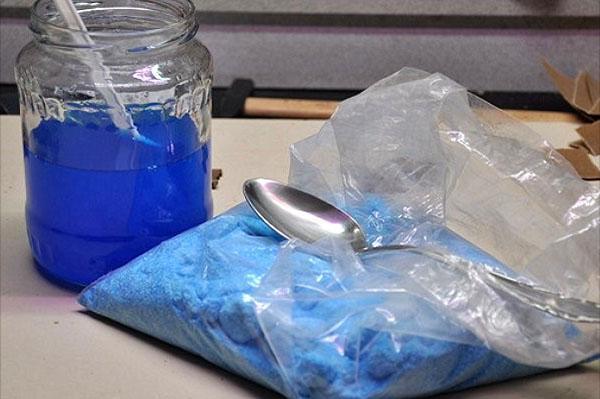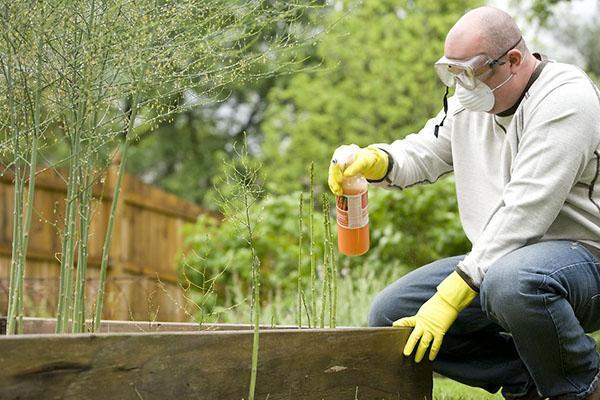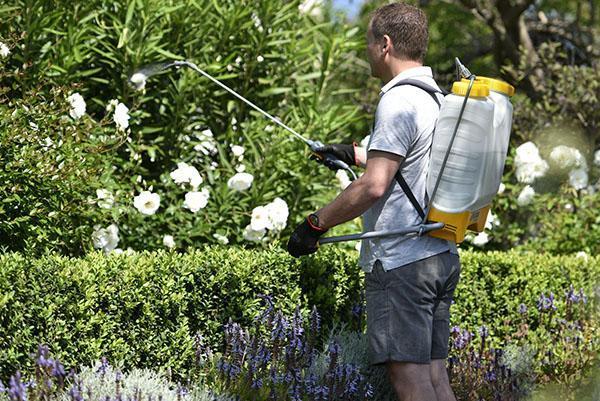What is copper sulfate for and how to use it in gardening
 Any summer resident wants to grow and collect strong, healthy vegetables, fruits and fruits, but the conditions in the beds are far from ideal. Copper sulfate, the use of which in horticulture has long proven its effectiveness, is one of the most famous fungicides that counteract pathogenic fungi.
Any summer resident wants to grow and collect strong, healthy vegetables, fruits and fruits, but the conditions in the beds are far from ideal. Copper sulfate, the use of which in horticulture has long proven its effectiveness, is one of the most famous fungicides that counteract pathogenic fungi.
The experience of using copper sulfate in horticulture and horticulture is more than a century. During this time, other chemically active compounds appeared, but copper sulfate is in demand today. Thanks to copper, this compound not only protects plants from dangerous diseases, but also has a beneficial effect on the quality of the crop.
Precautions when using copper sulfate in horticulture

Thoughtless use of copper sulfate can lead to the accumulation of copper in the fertile soil layer and water, burns and damage to the tissues of the treated plants, as well as to undesirable consequences for human health.
Therefore, it is important to adhere to:
- dosage of copper sulfate recommended for spraying trees in spring;
- terms of processing certain horticultural crops;
- safety precautions when working with chemicals, that is, use personal protective equipment.
Before working with copper sulfate, the gardener needs to take care of the presence of glasses, a respirator or cotton-gauze bandage, gloves, work clothes and easy-to-clean shoes. The solution is prepared in a separate container that does not have contact with food and drinking water.
When treating trees with copper sulfate in spring or with other methods of using the fungicide, make sure that there are no unprotected people and animals nearby. To exclude dangerous evaporation of the chemical, it is used at air temperatures below +30 ° C.
Terms of garden processing with copper sulfate
 The effectiveness of treatment with copper compounds depends on adherence to the instructions, the choice of dosage and the correct period of use. When to spray trees with copper sulfate, in spring, summer or autumn?
The effectiveness of treatment with copper compounds depends on adherence to the instructions, the choice of dosage and the correct period of use. When to spray trees with copper sulfate, in spring, summer or autumn?
A solution of copper sulfate is an active chemical liquid that has a drying and even burning effect. Spraying it on leaves and young shoots will not only protect against fungi, but also damage plants. In addition, copper sulfate acts only on spores, without affecting the overgrown mycelium. Therefore, copper sulfate is an excellent prevention and medicine for garden plantings when the first signs of damage appear.
It is advisable to use the drug for prevention. This is facilitated by the treatment of the garden with copper sulfate in early spring, when the leaves on the trees and shrubs have not yet unfolded, or in the fall, after they have fallen off.
At the same time, the trunks are irrigated with copper sulfate, which helps to get rid of the spores of fungi that accumulate in the surface layer of the soil and are transferred to the plants with the wind or water drops.
On green leaves, copper sulfate and preparations based on it are carefully used for treatment and prevention, until spores from the affected crops scattered to healthy plants.
Ways to use copper sulfate in gardening
 Instructions for the use of copper sulfate in horticulture describe the drug as a crystalline powder of blue or blue color, which becomes less intense with prolonged exposure to air, but returns if the copper sulfate, dissolving, comes into contact with moisture.
Instructions for the use of copper sulfate in horticulture describe the drug as a crystalline powder of blue or blue color, which becomes less intense with prolonged exposure to air, but returns if the copper sulfate, dissolving, comes into contact with moisture.
The most widely used tool is:
- affordable, effective antiseptic;
- fungicide for pre-planting preparation of tubers, seeds, treatment of trees and shrubs;
- preparation for improving the quality of soil with a low concentration of humus and copper deficiency.
On soils with a high sand content, on peatlands and other areas where plants suffer from copper deficiency, the preparation in powder form can be applied in early spring and before winter.
Copper sulfate is consumed at the rate of 1 gram per square meter, after mixing with a small amount of the substrate. On cultivated soils, the agent, in order to avoid the accumulation of copper, is applied at intervals of 4-5 years, in parallel crop rotation.
 The use of copper sulfate in spring gardening is not limited to powder. The soil is disinfected with a solution at a concentration of 5 grams of the agent per 10 liters of water. This measure helps to protect annual crops from fusarium, various types of rot, black leg.
The use of copper sulfate in spring gardening is not limited to powder. The soil is disinfected with a solution at a concentration of 5 grams of the agent per 10 liters of water. This measure helps to protect annual crops from fusarium, various types of rot, black leg.
At the height of the growing season, that is, in the middle of summer, if signs of chlorosis and growth inhibition appear on the plants, the soil under them is watered with a weak solution, about 1 gram of copper sulfate per 10 liters of water.
High concentration. 100 grams per 10 liters of water, copper sulfate defeats the causative agents of moniliosis, scab, clotterosporia, anthracnose and powdery mildew, coccomycosis, wilting and a number of spots. The active liquid perfectly disinfects damaged areas on the trunks of fruit and ornamental crops. In this case, the scope of application of copper sulfate in horticulture covers:
- stone fruits, including plums and cherries, apricots, thorns, sweet cherries and peaches;
- pears and apple trees;
- fruit bushes, for example, all varieties of currants, raspberries and gooseberries;
- grape vines.
In late autumn, roses are sprayed with a solution of 50 grams of copper sulfate in 10 liters of water. The seedlings are disinfected by immersing the root system in the liquid once. The same procedure, but with a twice weaker solution, is subjected to seedlings of garden strawberries and other green plants, and the chemical activity of the liquid is reduced by adding additional components.
 Before you breed copper sulfate for its use in gardening, you need to take care of a sufficient amount of funds.
Before you breed copper sulfate for its use in gardening, you need to take care of a sufficient amount of funds.
Average consumption for mature trees is 10 liters. Dwarf, young specimens and tall bushes require up to 2 liters, while ordinary shrubs take one and a half liters of liquid. During the treatment of plants, they make sure that the solution gets not only on the visible parts of the trunks and branches.
How to breed copper sulfate for gardening use
 A solution of copper sulfate has a limited duration of activity, therefore it is prepared before spraying fruit crops, processing planting material or green plants.
A solution of copper sulfate has a limited duration of activity, therefore it is prepared before spraying fruit crops, processing planting material or green plants.
How to breed copper sulfate for spraying trees? The blue powder is dissolved in a small volume of water, and then the liquid, stirring, is brought to the required concentration. Processing should be started immediately.
The best time for spraying is dry, calm weather with moderate cloudiness, covering the plants from direct sunlight. It is convenient to carry out the treatment in the early morning or evening, after sunset.
Since the action of copper sulfate and preparations based on it lasts about a week, and at least 4 hours must pass to achieve the required effect. If in the initial period the plants are exposed to rain or watering, the effect of vitriol will decrease.
With a lot of useful properties of copper sulfate, this remedy has a serious drawback - high acidity. Because of it, the solution burns the green parts of plants, young shoots and roots, so the scope of action of vitriol is very limited.
Lime helps to neutralize the toxicity of copper sulfate. Such a mixture, dissolved in water, is called Bordeaux liquid, has all the anti-fungal properties of vitriol and, with an average level of toxicity, does not seriously harm garden crops. Among the diseases given in front of the Bordeaux liquid are scab, late blight, mildew, anthracnose, rust and cercoporosis.
- Preparation of a product based on lime and copper sulfate for use in gardening chemicals are mixed separately from each other in plastic or glass containers. Metal dishes are not suitable due to the aggressiveness of the ingredients!
- Blue liquid is gradually poured into white lime milk, stirring constantly.
- Finally, the solution is filtered and used as directed.
 For the spring application of Bordeaux liquid, its concentration can be higher than in summer. Spraying of trees is carried out with a 3% solution, and for the treatment of green bushes of roses, strawberries, perennial flowers and shrubs, they make a gentle 1% composition.
For the spring application of Bordeaux liquid, its concentration can be higher than in summer. Spraying of trees is carried out with a 3% solution, and for the treatment of green bushes of roses, strawberries, perennial flowers and shrubs, they make a gentle 1% composition.
Slightly less effective is a liquid based on copper sulfate and soda ash. But such a mixture is easier to make by draining two pre-made solutions. Its drops on the leaves do not leave marks, and for better adhesion to the surface, you can add milk, soap or wood glue.
The summer resident has many ways to use copper sulfate in gardening. The main thing is to use this tool competently, without causing harm to either the plantings, or the soil, or the people around.